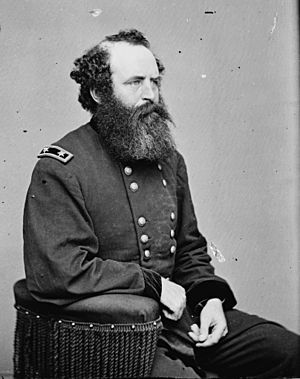Romeyn B. Ayres facts for kids
Quick facts for kids
Romeyn B. Ayres
|
|
|---|---|

Romeyn B. Ayres
|
|
| Born | December 20, 1825 East Creek, New York |
| Died | December 4, 1888 (aged 62) Fort Hamilton, New York |
| Place of burial | |
| Allegiance | United States of America Union |
| Service/ |
United States Army Union Army |
| Years of service | 1847–1888 |
| Rank | |
| Commands held | 2nd Division, V Corps 3rd U.S. Artillery 2nd U.S. Artillery |
| Battles/wars | American Civil War |
Romeyn Beck Ayres (born December 20, 1825 – died December 4, 1888) was an important Union Army general during the American Civil War. He was known for his bravery and leadership in many key battles.
Contents
Early Life and Military Training
Romeyn Ayres was born in a small town called East Creek, New York, near the Mohawk River. His father was a doctor who taught him Latin. Romeyn went to the West Point military academy, a famous school for training army officers. He graduated in 1847.
After graduating, he became a second lieutenant in the 4th U.S. Artillery. Even though he finished school during the Mexican–American War, he didn't see any fighting. Instead, he was stationed at military bases in Mexico until 1850.
Before the Civil War, Ayres served at different army posts. He also attended the Artillery School at Fort Monroe from 1859 to 1861, learning more about cannons and artillery.
Civil War Service
When the American Civil War began, Ayres was promoted to captain. He led a group of cannons, called a battery, in the 5th U.S. Artillery. He was involved in the First Battle of Bull Run, where his unit helped protect Union soldiers as they retreated.
In October 1861, Ayres became the chief of artillery for a division in the Army of the Potomac. He served in this role during major campaigns like the Peninsula Campaign and the Battle of Antietam. Just before the Battle of Fredericksburg, he was promoted to brigadier general. At Fredericksburg, he commanded the artillery units stationed on Falmouth Heights.
Switching to Infantry
Ayres realized that officers in the artillery were promoted slower than those in the infantry (foot soldiers). So, he decided to switch roles. In April 1863, he became a brigade commander in the 2nd Division of the V Corps. This division was special because it was made up mostly of regular army soldiers, not state volunteers.
He led his brigade in the Battle of Chancellorsville. His unit fought bravely but had to retreat when they were attacked from different sides.
Leading a Division at Gettysburg
During the Gettysburg Campaign, Ayres was promoted again to lead the Regular Division. This was a quick rise for someone with little infantry experience. At the Battle of Gettysburg, his division arrived on the second day of the battle, July 2, 1863.
Two of his brigades were sent to help other Union troops fighting in a tough area known as the Wheatfield. They faced heavy attacks and suffered many losses, but Ayres was praised for his actions. After Gettysburg, his division was sent to New York City to help stop the New York Draft Riots, which were violent protests against the military draft.
Later Campaigns and Promotions
In March 1864, the Union Army was reorganized. Ayres was given command of a brigade again, but soon after, he received command of a new 2nd Division in the V Corps. He led this division through Lt. Gen. Ulysses S. Grant's Overland Campaign and the long Siege of Petersburg.
Ayres was promoted to major general for his important contributions in these campaigns. He received special honors for his actions at the Battle of Globe Tavern and the Battle of Five Forks. He continued to lead his division all the way to the end of the war, including the Appomattox Campaign and the Confederate surrender.
After the war, Ayres famously said about his regular troops, "I had a division of regulars once. I buried half of them at Gettysburg and the other half in the Wilderness. There's no regulars left." This showed how much his soldiers had sacrificed.
After the War
After the Civil War ended, Ayres continued to serve in the army. He commanded a division and then a military district until 1866. He returned to the rank of lieutenant colonel in the regular army.
He was stationed at various military bases in the South, including Little Rock, Arkansas, and New Orleans, Louisiana. In 1877, he commanded troops who helped stop railroad strikes in Maryland and Pennsylvania. In 1879, he was promoted to colonel of the 2nd U.S. Artillery.
Romeyn Ayres died while still serving in the army on December 4, 1888, at Fort Hamilton, New York. He was 62 years old and was buried at Arlington National Cemetery in Virginia.

